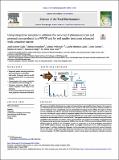Por favor, use este identificador para citar o enlazar a este item:
http://hdl.handle.net/10261/295999COMPARTIR / EXPORTAR:
 SHARE SHARE
 CORE
BASE CORE
BASE
|
|
| Visualizar otros formatos: MARC | Dublin Core | RDF | ORE | MODS | METS | DIDL | DATACITE | |

| Título: | Using integrative samplers to estimate the removal of pharmaceuticals and personal care products in a WWTP and by soil aquifer treatment enhanced with a reactive barrier |
Autor: | Sunyer-Caldú, Adrià CSIC ORCID; Benedetti, Barbara; Valhondo, Cristina CSIC ORCID ; Martínez-Landa, Lurdes; Carrera, Jesús CSIC ORCID; Di Carro, Marina; Magi, Emanuele; Diaz-Cruz, M. Silvia | Palabras clave: | Wastewater Contaminants of emerging concern (CECs) MAR (Managed Aquifer Recharge) Passive samplers UV filters |
Fecha de publicación: | 1-abr-2023 | Editor: | Elsevier | Citación: | Science of The Total Environment 867: 161466 (2023) | Resumen: | The need and availability of freshwater is a major environmental issue, aggravated by climate change. It is necessary to find alternative sources of freshwater. Wastewater could represent a valid option but requires extensive treatment to remove wastewater-borne contaminants, such as contaminants of emerging concern (CECs). It is urgent to develop not only sustainable and effective wastewater treatment techniques, but also water quality assessment methods. In this study, we used polar organic chemical integrative samplers (POCIS) to investigate the presence and abatement of contaminants in an urban wastewater treatment plant (WWTP) and in soil aquifer treatment (SAT) systems (a conventional one and one enhanced with a reactive barrier). This approach allowed us to overcome inter-day and intraday variability of the wastewater composition. Passive sampler extracts were analyzed to investigate contamination from 56 pharmaceuticals and personal care products (PPCPs). Data from the POCIS were used to estimate PPCPs' removal efficiency along the WWTP and the SAT systems. A total of 31 compounds, out of the 56 investigated, were detected in the WWTP influent. Removal rates along WWTP were highly variable (16-100 %), with benzophenone-3, benzophenone-1, parabens, ciprofloxacin, ibuprofen, and acetaminophen as the most effectively removed chemicals. The two SAT systems yielded much higher elimination rates than those achieved through the primary and secondary treatments together. The SAT system that integrated a reactive barrier, based on sustainable materials to promote enhanced elimination of CECs, was significantly more efficient than the conventional one. The removal of the recalcitrant carbamazepine and its epoxy- metabolite was especially remarkable in this SAT, with removal rates between 69-81 % and 63-70 %, respectively. | Versión del editor: | https://doi.org/10.1016/j.scitotenv.2023.161466 | URI: | http://hdl.handle.net/10261/295999 | DOI: | 10.1016/j.scitotenv.2023.161466 |
| Aparece en las colecciones: | (IDAEA) Artículos |
Ficheros en este ítem:
| Fichero | Descripción | Tamaño | Formato | |
|---|---|---|---|---|
| 1-s2.0-S0048969723000815-main.pdf | Artículo principal | 1,41 MB | Adobe PDF |  Visualizar/Abrir |
| 1-s2.0-S0048969723000815-mmc1.docx | Material suplementario | 1,6 MB | Microsoft Word XML | Visualizar/Abrir |
CORE Recommender
PubMed Central
Citations
2
checked on 26-abr-2024
SCOPUSTM
Citations
6
checked on 26-abr-2024
WEB OF SCIENCETM
Citations
2
checked on 29-feb-2024
Page view(s)
42
checked on 29-abr-2024
Download(s)
131
checked on 29-abr-2024
Google ScholarTM
Check
Altmetric
Altmetric
Artículos relacionados:
NOTA: Los ítems de Digital.CSIC están protegidos por copyright, con todos los derechos reservados, a menos que se indique lo contrario.
